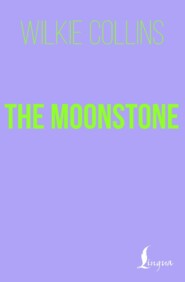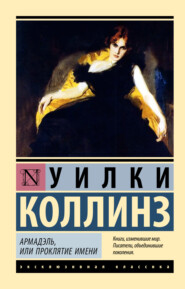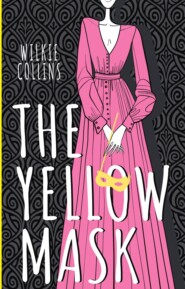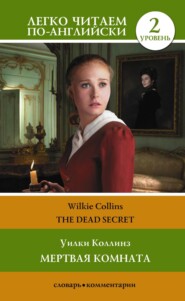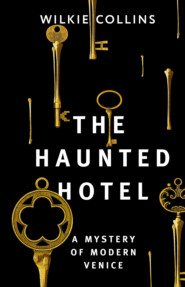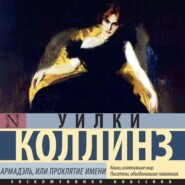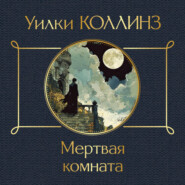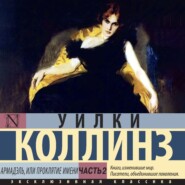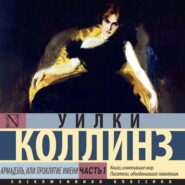По всем вопросам обращайтесь на: info@litportal.ru
(©) 2003-2025.
✖
The Moonstone
Автор
Год написания книги
2019
Настройки чтения
Размер шрифта
Высота строк
Поля
The Moonstone
Wilkie Collins
HarperCollins is proud to present its new range of best-loved, essential classics.‘The horrid mystery hanging over us in this house gets into my head like liquor, and makes me wild.’Centred around a glorious yellow diamond that carries with it a menacing history, The Moonstone tells the story of Rachel Verinder, who inherits the stone on her eighteenth birthday. That very evening, the diamond is stolen and there begins an epic enquiry into hunting down the thief. At the same time, three Indian men, Brahmin guardians of the diamond are attempting to reclaim the stone in order to return it to their sacred Hindu Idol.Told from the perspective of 11different characters, Wilkie Collins’ tale of mystery and suspicion was considered the first modern English detective novel at its time of publication.
THE MOONSTONE
Wilkie Collins
CONTENTS
Cover (#u226e979c-cc21-5128-8cfe-4c5f24c3bbe6)
Title Page (#uce9de5a1-3487-5063-8cbf-9f6cbf760506)
Introduction (#ulink_19b5276e-dfab-529c-b785-849198e1ddd8)
Preface (#ulink_a1ce9cd2-d9c7-5d08-a18c-5f1fa3f6a7c2)
Preface to a New Edition (#ulink_2ba58469-6ff9-5748-b36a-c93f1204d8c8)
Prologue: The Storming of Seringapatam (1799) (#ulink_c9b28f77-6b06-5d70-a2da-0b87b155640d)
Part 1 First Period (#litres_trial_promo)
Chapter 1 The Loss of the Diamond (1848) (#ulink_212a229d-9142-5e08-bf59-73513e7ec29e)
Part 2 Second Period (#litres_trial_promo)
Chapter 2 The Discovery of the Truth (1848â1849) (#litres_trial_promo)
Epilogue (#litres_trial_promo)
Chapter 3 The Finding of the Diamond (#litres_trial_promo)
Classic Literature: Words and Phrases Adapted from the Collins English Dictionary (#litres_trial_promo)
About the Author (#litres_trial_promo)
History of Collins (#litres_trial_promo)
Copyright (#litres_trial_promo)
About the Publisher (#litres_trial_promo)
INTRODUCTION (#ulink_12263567-9e09-55fc-926b-509dfcfc3909)
In the year 1928, when the boom in âseriousâ detective-novel writing which began round about the first world war was nearing its height, and the âart and scienceâ of it was being very seriously discussed, an eminent detective novelist, in a forty-five page introduction to a vast collection of stories, let fall the opinion that âThe Moonstone is probably the finest detective story ever written.â Until that date, Wilkie Collins had been slightly regarded by connoisseurs, unless they were specialists in lesser Victorian fictionââIn the British Museum catalogue,â discovered the shocked author of this encomium, âonly two studies of this celebrated mystery-monger are listed: one is by an American, and the other by a German.â Thereafter, however, he became great; he was almost canonised as the direct ancestor of Sherlock Holmes, Dr. Thorndyke, Hercule Poirot, Lemmy Caution, and all the tribe.
It is interesting, therefore, to observe that Collins himself did not think of The Moonstone as a detective story at all. This was not because the genre had not yet come into existence. The solution of a crime by the exercise of pure ratiocination on the part of a single mind had been set out in classic form twenty years before by Edgar Allan Poe in The Murders in the Rue Morgueâin which, incidentally, the character-scheme of Dupin plus adoring chronicler set the convenient pattern which was repeated in Holmes plus Watson, Poirot plus Hastings, and many other subsequent combinations. In France, also, the roman policier was developing fast in the hands of Gaboriau and Du Boisgobey. Collins, if he had wanted to write, âthe finest detective story,â had no lack of models; but he did not. What he himself thought of the intention of his own novelâand he presumably knew what he meant to doâhe set out in the preface:
âThe attempt made, here, is to trace the influence of character on circumstances. The conduct pursued, under a sudden emergency, by a young girl (Rachel Verinder) supplies the foundation on which I have built this book.â
He goes on to say that he has endeavoured to make his subsidiary characters behave as they would have behaved; and adds that his account of the âphysiological experimentââthe dosing of Franklin Blake with laudanum in order to induce him to repeat his sleep-walking actions on the night of the disappearance of the Moonstoneâis based on a careful study of books and of living authorities. Clearly what interested the author of The Moonstone was not the detail of the theft of the gem and the subsequent tracking down of those responsible, but the effect of the whole series of events on the behaviour of his characters. That is to say, he was writing a novel with a plot, not a cross-word puzzle.
There are, of course, elements in The Moonstone which have since become classic detective-story-componentsâso classic, indeed, that later writers seeking to avoid monotony have drawn especial attention to the fact that they are not using the established formula. There is the very stupid policeman, in this case Superintendent Seegrave, who is a worthy ancestor of Lestrade, Inspector Japp, and of all the police officers whom Dr. Thorndyke bewildered in his day. There is the crime brought home, after suspicion has been well distributed to the most unlikely persons; although, on the other hand, Collins is scrupulously fair and makes no attempt to confuse the reader by presenting the real criminal as a person too attractive to be mistrusted. There are some clues, notably the paint-stained nightgown, though the paint-stained nightgown does not solve the mystery; it is, in fact, not much more use to Sergeant Cuff than a blood-stained nightgown was to that unfortunate Detective Whicher whom some suppose to have been the real life model for the Sergeant. (The Constance Kent case, as a matter of fact, except for the incident of the nightgown, bears practically no resemblance to the plot of The Moonstone.) Finally, there is the clear attempt to build up Sergeant Cuff into a âcharacter,â by stressing his peculiar physical appearance and his reiterated interest in the growing of roses. This might legitimately be regarded as a foreshadowing of the long array of detectives noted for personal idiosyncrasiesâSherlock Holmes above all, but including also Lord Peter Wimsey, with his collectorâs mania, the blind Max Carrados of Ernest Bramah, Baroness Orczyâs Old Man in the Corner, who fiddled with string, and a dozen others, as well as some whose distinguishing characteristic is proudly stated to be that of possessing none whatever.
The creation of an idiosyncratic and therefore easily-memorised detective is one of the established tricks of the trade, enabling the detective to last out a course of thirty to fifty novels, and so to fix himself in the publicâs mind that at the circulating library counter the inveterate asks for âthe new Poirotâ or whatever it may be. Sophisticated moderns may, however, observe that Sergeant Cuffâs roses are rather over-stressed, and have very little relevance to the matter in hand; and, more devastatingly, that Sergeant Cuff, though doing in the course of the book, some pretty detection, was quite wrong in his conclusions, and did not solve the mystery in this, his first recorded case. He does not appear, in TheMoonstone, likely to earn his creator the modest competence which writers of detective stories expect by solving twenty or thirty problems in the future. He is no omniscient, no Great BrainâPoeâs Dupin is a far more plausible prototype for the twentieth-century paladins. Sergeant Cuff is what his creator intended him to be, a character in his own right, a policeman playing a part in a story of real people with a mystery at its heart.
This type of story was extremely common in the mid-Victorian eraâa fact which the sudden glorification of The Moonstone tends to obscure. The Victorians loved a mystery, or a crime, or both, set in the ordinary development of plot. The greatest of them all has made his contribution in the unsolved Mystery of Edwin Drood; but few people appear to remember nowadays how many of the popular Victorian novels had a mystery (often involving a policeman) as their main or subsidiary plot. Leaving aside other books of Collinsâ own, such as No Name or Armadale, we may turn to Trollope and note, among many possible candidates, Is He Popenjoy?, a mystery of inheritance, the murder of Mr. Bonteen, which takes up so much of the space of Phineas Redux, Orley Farm, and the theft story in the Last Chronicle of Barset.
Let us go a little further afield. Mrs. Henry Wood is chiefly known, to this generation, for the sensational sentimentalities of East Lynneâitself in some sort a mystery novel. But a very much better book of hersâThe Channingsâwhich deserves a revival, contains within its 450 pages no fewer than three mysteries. It begins with the problem of a choristerâs surplice found stained with ink, to the great disgrace of the cathedral schoolâit is only close to the end of the book that this ill-deed is finally brought home to the most disagreeable of a disagreeable family, Gerald Yorke. It continues with the theft of a twenty-pound note, for which the noble Arthur Channing long bears the blameâthe situation being further confused by speculation as to how Hamish Channing, Arthurâs brother, was suddenly in a position to pay off his small scale creditors; and further chronicles the complete disappearance of Charley, the youngest Channing, after having been frightened by a bogus ghost in the cathedral cloisters. It must be admitted that the eminent authoress, having landed herself with a slight over-plus of plot, shows a lamentable lack of interest in Charley Channing, only restoring him to life, with a minimum of explanation, in time for the happy reunion at the end of the book; also that Mr. Butterby, the representative of the law, is exhibited as singularly incompetent. Nevertheless, The Channings is a novel which, like The Moonstone, traces âthe influence of character on circumstances,â and particularly of characters in contact with crime. The long Johnny Ludlow series, by the same author, is also very much concerned with crime and its detection and (or) punishment; and to enter yet more respectable precincts, it should be remembered that Charlotte Yonge, whose saga-volumes of Victorian family life now fetch such high second-hand prices, devoted the whole of one book, The Trial, to a murder-mystery, and that a large part even of The Daisy Chain turns on the questions âwho inked the school-masterâs book?â and âwill Norman Mayâs character be re-established?â
The list could be extended almost indefinitely. Henry Kingsleyâs once very popular Ravenshoe is written around a mystery of parentage which dictates most of the plot. The point to realise is that the Victorian story-tellers, and the Victorian story-readers, accepted crime and punishment as things that might happen to anyone in the course of lifeâand made the life-story that much more readable if they did happen. But these crimes and punishments happened to real charactersâor characters as real as the novelistâs ability could compass. The characters were not subordinated and compelled to dance around to the exigencies of a plot which demands a body in a country-house library, a number of resident guests and servants each with their own discreditable and penetrable motives for murder, a paraphernalia of scientific instruments of detection, and a veneer of literary erudition to cover up the lack of any human interest; they were not imprisoned in a depressing mechanistic pattern. As counterbalance, of course, the Victorian novels tend to lack the puzzle fascination; they know little of the natural habitat of duck-weeds (Freeman) or the technique of electro-plating a murdered corpse so as to serve as a studio couch (Sayers). And the suspense they engender is not so much suspense about the identity of the criminal as suspense about how the innocently-accused is to be vindicated and the happy ending brought about without too many broken homes and death-beds on the way. (It must be admitted that Mrs. Henry Wood overindulged in death-beds as much as Trollope did in inheritance problems.) By all these criteria, The Moonstone is a Victorian novel, and not a detective story.
Not that it is any the worse for that. As a story, it is a very good one, excellently deployed, and it dispenses with any adventitious sensationalism. The death of Rosanna Spearman arises directly out of the character and past history of Rosanna Spearman; and in view of the date at which the book was written, the absence of any sentimentalising over that unfortunate girl is quite remarkable. Subsequent detective novelistsânot, fortunately, Conan Doyleâwere too often constrained, either by their publishers or by their own conception of what the public wanted, to insert a âlove-interestâ into their novels. âLove-interestâ not fitting very well into mechanistic plots, the result was often deplorable. There is no need to particularise, only to mention that the introduction of a young lovely burning to avenge the corpse, or devoted to the chief suspectâor in any other capacityâtends seriously to hamper the activities of a detective who is working out the possible permutations of Bradshaw, or the chemical composition of a piece of tarred rope, or the significance of quotations from the works of T. S. Eliot scattered in unlikely places. It is not without significance that the English fictional detectives who have stayed the course best have been those expressly immune to amorous adventureâSherlock Holmes, an egocentric neurotic, Dr. Thorndyke, a handsome kindly âblock of teak,â Father Brown, a priest, Dr. Priestly, a disagreeable elderly scientist, and several policemen happily married to undistinguished wives: their French counterparts fall in and out of love with the victim, the criminal, or bothâbut that is Gallic levity frowned upon across the Channel.
In The Moonstone, however, there is a love-interest, that of the relations of Franklin Blake with the two women who loved him, which is both interesting and relevant to the story; and the further device of narration in turns by the people directly concerned adds to the human interest. No matter that it is not very probable that Gabriel Betteredge would ever have succeeded in putting pen to paper so as to cover the pages which he is made to cover here; this is what Gabriel, being Gabriel, would have written if he could have written it at such length. Similarly, this is what Miss Drusilla Clack would have written had she been completely frankâas, with a pen in her hand, she would probably not have been. And so with the rest. The net effect of all of which is that, though the paraphernalia of the Indian temple and the Buddhist priests is rather hastily written in, and though The Moonstone cannot be regarded as the master-pattern of the modern detective story, it remains something much more permanentâa thoroughly good novel.
G. D. H. and Margaret Cole
PREFACE (#ulink_72709d7a-f21b-5876-b785-d7379c78b1c0)
In some of my former novels, the object proposed has been to trace the influence of circumstances upon character. In the present story I have reversed the process. The attempt made here is to trace the influence of character on circumstances. The conduct pursued, under a sudden emergency, by a young girl, supplies the foundation on which I have built this book.
The same object has been kept in view in the handling of the other characters which appear in these pages. Their course of thought and action under the circumstances which surround them is shown to be (what it would most probably have been in real life) sometimes right and sometimes wrong. Right or wrong, their conduct, in either event, equally directs the course of those portions of the story in which they are concerned.
In the case of the physiological experiment which occupies a prominent place in the closing scenes of The Moonstone, the same principle has guided me once more. Having first ascertained, not only from books, but from living authorities as well, what the result of that experiment would really have been, I have declined to avail myself of the novelistâs privilege of supposing something which might have happened, and have so shaped the story as to make it grow out of what actually would have happenedâwhich, I beg to inform my readers, is also what actually does happen, in these pages.
With reference to the story of the Diamond, as here set forth. I have to acknowledge that it is founded, in some important particulars, on the stories of two of the royal diamonds of Europe. The magnificent stone which adorns the top of the Russian Imperial Sceptre was once the eye of an Indian idol. The famous Koh-i-Noor is also supposed to have been one of the sacred gems of India; and, more than this, to have been the subject of a prediction, which prophesied certain misfortune to the persons who should divert it from its ancient uses.
Gloucester Place, Portman Square,
June 30th, 1868.
PREFACE TO A NEW EDITION (#ulink_d57e8ae5-83ad-5f61-a1e6-593b7542662d)
The circumstances under which The Moonstone was originally written have invested the bookâin the authorâs mindâwith an interest peculiarly its own.
While this work was still in course of periodical publication in England and in the United States, and when not more than one-third of it was completed, the bitterest affliction of my life and the severest illness from which I have ever suffered fell on me together. At the time when my mother lay dying in her little cottage in the country, I was struck prostrate, in Londonâcrippled in every limb by the torture of rheumatic gout. Under the weight of this double calamity, I had my duty to the public still to bear in mind. My good readers in England and in America whom I had never yet disappointed, were expecting their regular weekly instalments of the new story. I held to the storyâfor my own sake as well as for theirs. In the intervals of grief, in the occasional remissions of pain, I dictated from my bed that portion of The Moonstone which has since proved most successful in amusing the publicâthe âNarrative of Miss Clack.â Of the physical sacrifice which the effort cost me I shall say nothing. I only look back now at the blessed relief which my occupation (forced as it was) brought to my mind. The Art which had been always the pride and the pleasure of my life became now more than ever âits own exceeding great reward.â I doubt if I should have lived to write another book, if the responsibility of the weekly publication of this story had not forced me to rally my sinking energies of body and mindâto dry my useless tears, and to conquer my merciless pains.
The novel completed, I awaited its reception by the public with an eagerness of anxiety which I have never felt before or since for the fate of any other writings of mine. If The Moonstone had failed, my mortification would have been bitter indeed. As it was, the welcome accorded to the story in England, in America, and on the Continent of Europe was instantly and universally favourable. Never have I had better reason than this work has given me to feel gratefully to novel-readers of all nations. Everywhere my characters made friends, and my story roused interest, Everywhere the public favour looked over my faultsâand repaid me a hundredfold for the hard toil which these pages cost me in the dark time of sickness and grief.
I have only to add that the present edition has had the benefit of my careful revision. All that I can do towards making the book worthy of the readerâs continued approval has now been done.
W. C.
May, 1871.
PROLOGUE The Storming of Seringapatam (1799) (#ulink_2c4729bb-83ae-53d6-bd6c-778188cb0f65)Extracted from a Family Paper
Wilkie Collins
HarperCollins is proud to present its new range of best-loved, essential classics.‘The horrid mystery hanging over us in this house gets into my head like liquor, and makes me wild.’Centred around a glorious yellow diamond that carries with it a menacing history, The Moonstone tells the story of Rachel Verinder, who inherits the stone on her eighteenth birthday. That very evening, the diamond is stolen and there begins an epic enquiry into hunting down the thief. At the same time, three Indian men, Brahmin guardians of the diamond are attempting to reclaim the stone in order to return it to their sacred Hindu Idol.Told from the perspective of 11different characters, Wilkie Collins’ tale of mystery and suspicion was considered the first modern English detective novel at its time of publication.
THE MOONSTONE
Wilkie Collins
CONTENTS
Cover (#u226e979c-cc21-5128-8cfe-4c5f24c3bbe6)
Title Page (#uce9de5a1-3487-5063-8cbf-9f6cbf760506)
Introduction (#ulink_19b5276e-dfab-529c-b785-849198e1ddd8)
Preface (#ulink_a1ce9cd2-d9c7-5d08-a18c-5f1fa3f6a7c2)
Preface to a New Edition (#ulink_2ba58469-6ff9-5748-b36a-c93f1204d8c8)
Prologue: The Storming of Seringapatam (1799) (#ulink_c9b28f77-6b06-5d70-a2da-0b87b155640d)
Part 1 First Period (#litres_trial_promo)
Chapter 1 The Loss of the Diamond (1848) (#ulink_212a229d-9142-5e08-bf59-73513e7ec29e)
Part 2 Second Period (#litres_trial_promo)
Chapter 2 The Discovery of the Truth (1848â1849) (#litres_trial_promo)
Epilogue (#litres_trial_promo)
Chapter 3 The Finding of the Diamond (#litres_trial_promo)
Classic Literature: Words and Phrases Adapted from the Collins English Dictionary (#litres_trial_promo)
About the Author (#litres_trial_promo)
History of Collins (#litres_trial_promo)
Copyright (#litres_trial_promo)
About the Publisher (#litres_trial_promo)
INTRODUCTION (#ulink_12263567-9e09-55fc-926b-509dfcfc3909)
In the year 1928, when the boom in âseriousâ detective-novel writing which began round about the first world war was nearing its height, and the âart and scienceâ of it was being very seriously discussed, an eminent detective novelist, in a forty-five page introduction to a vast collection of stories, let fall the opinion that âThe Moonstone is probably the finest detective story ever written.â Until that date, Wilkie Collins had been slightly regarded by connoisseurs, unless they were specialists in lesser Victorian fictionââIn the British Museum catalogue,â discovered the shocked author of this encomium, âonly two studies of this celebrated mystery-monger are listed: one is by an American, and the other by a German.â Thereafter, however, he became great; he was almost canonised as the direct ancestor of Sherlock Holmes, Dr. Thorndyke, Hercule Poirot, Lemmy Caution, and all the tribe.
It is interesting, therefore, to observe that Collins himself did not think of The Moonstone as a detective story at all. This was not because the genre had not yet come into existence. The solution of a crime by the exercise of pure ratiocination on the part of a single mind had been set out in classic form twenty years before by Edgar Allan Poe in The Murders in the Rue Morgueâin which, incidentally, the character-scheme of Dupin plus adoring chronicler set the convenient pattern which was repeated in Holmes plus Watson, Poirot plus Hastings, and many other subsequent combinations. In France, also, the roman policier was developing fast in the hands of Gaboriau and Du Boisgobey. Collins, if he had wanted to write, âthe finest detective story,â had no lack of models; but he did not. What he himself thought of the intention of his own novelâand he presumably knew what he meant to doâhe set out in the preface:
âThe attempt made, here, is to trace the influence of character on circumstances. The conduct pursued, under a sudden emergency, by a young girl (Rachel Verinder) supplies the foundation on which I have built this book.â
He goes on to say that he has endeavoured to make his subsidiary characters behave as they would have behaved; and adds that his account of the âphysiological experimentââthe dosing of Franklin Blake with laudanum in order to induce him to repeat his sleep-walking actions on the night of the disappearance of the Moonstoneâis based on a careful study of books and of living authorities. Clearly what interested the author of The Moonstone was not the detail of the theft of the gem and the subsequent tracking down of those responsible, but the effect of the whole series of events on the behaviour of his characters. That is to say, he was writing a novel with a plot, not a cross-word puzzle.
There are, of course, elements in The Moonstone which have since become classic detective-story-componentsâso classic, indeed, that later writers seeking to avoid monotony have drawn especial attention to the fact that they are not using the established formula. There is the very stupid policeman, in this case Superintendent Seegrave, who is a worthy ancestor of Lestrade, Inspector Japp, and of all the police officers whom Dr. Thorndyke bewildered in his day. There is the crime brought home, after suspicion has been well distributed to the most unlikely persons; although, on the other hand, Collins is scrupulously fair and makes no attempt to confuse the reader by presenting the real criminal as a person too attractive to be mistrusted. There are some clues, notably the paint-stained nightgown, though the paint-stained nightgown does not solve the mystery; it is, in fact, not much more use to Sergeant Cuff than a blood-stained nightgown was to that unfortunate Detective Whicher whom some suppose to have been the real life model for the Sergeant. (The Constance Kent case, as a matter of fact, except for the incident of the nightgown, bears practically no resemblance to the plot of The Moonstone.) Finally, there is the clear attempt to build up Sergeant Cuff into a âcharacter,â by stressing his peculiar physical appearance and his reiterated interest in the growing of roses. This might legitimately be regarded as a foreshadowing of the long array of detectives noted for personal idiosyncrasiesâSherlock Holmes above all, but including also Lord Peter Wimsey, with his collectorâs mania, the blind Max Carrados of Ernest Bramah, Baroness Orczyâs Old Man in the Corner, who fiddled with string, and a dozen others, as well as some whose distinguishing characteristic is proudly stated to be that of possessing none whatever.
The creation of an idiosyncratic and therefore easily-memorised detective is one of the established tricks of the trade, enabling the detective to last out a course of thirty to fifty novels, and so to fix himself in the publicâs mind that at the circulating library counter the inveterate asks for âthe new Poirotâ or whatever it may be. Sophisticated moderns may, however, observe that Sergeant Cuffâs roses are rather over-stressed, and have very little relevance to the matter in hand; and, more devastatingly, that Sergeant Cuff, though doing in the course of the book, some pretty detection, was quite wrong in his conclusions, and did not solve the mystery in this, his first recorded case. He does not appear, in TheMoonstone, likely to earn his creator the modest competence which writers of detective stories expect by solving twenty or thirty problems in the future. He is no omniscient, no Great BrainâPoeâs Dupin is a far more plausible prototype for the twentieth-century paladins. Sergeant Cuff is what his creator intended him to be, a character in his own right, a policeman playing a part in a story of real people with a mystery at its heart.
This type of story was extremely common in the mid-Victorian eraâa fact which the sudden glorification of The Moonstone tends to obscure. The Victorians loved a mystery, or a crime, or both, set in the ordinary development of plot. The greatest of them all has made his contribution in the unsolved Mystery of Edwin Drood; but few people appear to remember nowadays how many of the popular Victorian novels had a mystery (often involving a policeman) as their main or subsidiary plot. Leaving aside other books of Collinsâ own, such as No Name or Armadale, we may turn to Trollope and note, among many possible candidates, Is He Popenjoy?, a mystery of inheritance, the murder of Mr. Bonteen, which takes up so much of the space of Phineas Redux, Orley Farm, and the theft story in the Last Chronicle of Barset.
Let us go a little further afield. Mrs. Henry Wood is chiefly known, to this generation, for the sensational sentimentalities of East Lynneâitself in some sort a mystery novel. But a very much better book of hersâThe Channingsâwhich deserves a revival, contains within its 450 pages no fewer than three mysteries. It begins with the problem of a choristerâs surplice found stained with ink, to the great disgrace of the cathedral schoolâit is only close to the end of the book that this ill-deed is finally brought home to the most disagreeable of a disagreeable family, Gerald Yorke. It continues with the theft of a twenty-pound note, for which the noble Arthur Channing long bears the blameâthe situation being further confused by speculation as to how Hamish Channing, Arthurâs brother, was suddenly in a position to pay off his small scale creditors; and further chronicles the complete disappearance of Charley, the youngest Channing, after having been frightened by a bogus ghost in the cathedral cloisters. It must be admitted that the eminent authoress, having landed herself with a slight over-plus of plot, shows a lamentable lack of interest in Charley Channing, only restoring him to life, with a minimum of explanation, in time for the happy reunion at the end of the book; also that Mr. Butterby, the representative of the law, is exhibited as singularly incompetent. Nevertheless, The Channings is a novel which, like The Moonstone, traces âthe influence of character on circumstances,â and particularly of characters in contact with crime. The long Johnny Ludlow series, by the same author, is also very much concerned with crime and its detection and (or) punishment; and to enter yet more respectable precincts, it should be remembered that Charlotte Yonge, whose saga-volumes of Victorian family life now fetch such high second-hand prices, devoted the whole of one book, The Trial, to a murder-mystery, and that a large part even of The Daisy Chain turns on the questions âwho inked the school-masterâs book?â and âwill Norman Mayâs character be re-established?â
The list could be extended almost indefinitely. Henry Kingsleyâs once very popular Ravenshoe is written around a mystery of parentage which dictates most of the plot. The point to realise is that the Victorian story-tellers, and the Victorian story-readers, accepted crime and punishment as things that might happen to anyone in the course of lifeâand made the life-story that much more readable if they did happen. But these crimes and punishments happened to real charactersâor characters as real as the novelistâs ability could compass. The characters were not subordinated and compelled to dance around to the exigencies of a plot which demands a body in a country-house library, a number of resident guests and servants each with their own discreditable and penetrable motives for murder, a paraphernalia of scientific instruments of detection, and a veneer of literary erudition to cover up the lack of any human interest; they were not imprisoned in a depressing mechanistic pattern. As counterbalance, of course, the Victorian novels tend to lack the puzzle fascination; they know little of the natural habitat of duck-weeds (Freeman) or the technique of electro-plating a murdered corpse so as to serve as a studio couch (Sayers). And the suspense they engender is not so much suspense about the identity of the criminal as suspense about how the innocently-accused is to be vindicated and the happy ending brought about without too many broken homes and death-beds on the way. (It must be admitted that Mrs. Henry Wood overindulged in death-beds as much as Trollope did in inheritance problems.) By all these criteria, The Moonstone is a Victorian novel, and not a detective story.
Not that it is any the worse for that. As a story, it is a very good one, excellently deployed, and it dispenses with any adventitious sensationalism. The death of Rosanna Spearman arises directly out of the character and past history of Rosanna Spearman; and in view of the date at which the book was written, the absence of any sentimentalising over that unfortunate girl is quite remarkable. Subsequent detective novelistsânot, fortunately, Conan Doyleâwere too often constrained, either by their publishers or by their own conception of what the public wanted, to insert a âlove-interestâ into their novels. âLove-interestâ not fitting very well into mechanistic plots, the result was often deplorable. There is no need to particularise, only to mention that the introduction of a young lovely burning to avenge the corpse, or devoted to the chief suspectâor in any other capacityâtends seriously to hamper the activities of a detective who is working out the possible permutations of Bradshaw, or the chemical composition of a piece of tarred rope, or the significance of quotations from the works of T. S. Eliot scattered in unlikely places. It is not without significance that the English fictional detectives who have stayed the course best have been those expressly immune to amorous adventureâSherlock Holmes, an egocentric neurotic, Dr. Thorndyke, a handsome kindly âblock of teak,â Father Brown, a priest, Dr. Priestly, a disagreeable elderly scientist, and several policemen happily married to undistinguished wives: their French counterparts fall in and out of love with the victim, the criminal, or bothâbut that is Gallic levity frowned upon across the Channel.
In The Moonstone, however, there is a love-interest, that of the relations of Franklin Blake with the two women who loved him, which is both interesting and relevant to the story; and the further device of narration in turns by the people directly concerned adds to the human interest. No matter that it is not very probable that Gabriel Betteredge would ever have succeeded in putting pen to paper so as to cover the pages which he is made to cover here; this is what Gabriel, being Gabriel, would have written if he could have written it at such length. Similarly, this is what Miss Drusilla Clack would have written had she been completely frankâas, with a pen in her hand, she would probably not have been. And so with the rest. The net effect of all of which is that, though the paraphernalia of the Indian temple and the Buddhist priests is rather hastily written in, and though The Moonstone cannot be regarded as the master-pattern of the modern detective story, it remains something much more permanentâa thoroughly good novel.
G. D. H. and Margaret Cole
PREFACE (#ulink_72709d7a-f21b-5876-b785-d7379c78b1c0)
In some of my former novels, the object proposed has been to trace the influence of circumstances upon character. In the present story I have reversed the process. The attempt made here is to trace the influence of character on circumstances. The conduct pursued, under a sudden emergency, by a young girl, supplies the foundation on which I have built this book.
The same object has been kept in view in the handling of the other characters which appear in these pages. Their course of thought and action under the circumstances which surround them is shown to be (what it would most probably have been in real life) sometimes right and sometimes wrong. Right or wrong, their conduct, in either event, equally directs the course of those portions of the story in which they are concerned.
In the case of the physiological experiment which occupies a prominent place in the closing scenes of The Moonstone, the same principle has guided me once more. Having first ascertained, not only from books, but from living authorities as well, what the result of that experiment would really have been, I have declined to avail myself of the novelistâs privilege of supposing something which might have happened, and have so shaped the story as to make it grow out of what actually would have happenedâwhich, I beg to inform my readers, is also what actually does happen, in these pages.
With reference to the story of the Diamond, as here set forth. I have to acknowledge that it is founded, in some important particulars, on the stories of two of the royal diamonds of Europe. The magnificent stone which adorns the top of the Russian Imperial Sceptre was once the eye of an Indian idol. The famous Koh-i-Noor is also supposed to have been one of the sacred gems of India; and, more than this, to have been the subject of a prediction, which prophesied certain misfortune to the persons who should divert it from its ancient uses.
Gloucester Place, Portman Square,
June 30th, 1868.
PREFACE TO A NEW EDITION (#ulink_d57e8ae5-83ad-5f61-a1e6-593b7542662d)
The circumstances under which The Moonstone was originally written have invested the bookâin the authorâs mindâwith an interest peculiarly its own.
While this work was still in course of periodical publication in England and in the United States, and when not more than one-third of it was completed, the bitterest affliction of my life and the severest illness from which I have ever suffered fell on me together. At the time when my mother lay dying in her little cottage in the country, I was struck prostrate, in Londonâcrippled in every limb by the torture of rheumatic gout. Under the weight of this double calamity, I had my duty to the public still to bear in mind. My good readers in England and in America whom I had never yet disappointed, were expecting their regular weekly instalments of the new story. I held to the storyâfor my own sake as well as for theirs. In the intervals of grief, in the occasional remissions of pain, I dictated from my bed that portion of The Moonstone which has since proved most successful in amusing the publicâthe âNarrative of Miss Clack.â Of the physical sacrifice which the effort cost me I shall say nothing. I only look back now at the blessed relief which my occupation (forced as it was) brought to my mind. The Art which had been always the pride and the pleasure of my life became now more than ever âits own exceeding great reward.â I doubt if I should have lived to write another book, if the responsibility of the weekly publication of this story had not forced me to rally my sinking energies of body and mindâto dry my useless tears, and to conquer my merciless pains.
The novel completed, I awaited its reception by the public with an eagerness of anxiety which I have never felt before or since for the fate of any other writings of mine. If The Moonstone had failed, my mortification would have been bitter indeed. As it was, the welcome accorded to the story in England, in America, and on the Continent of Europe was instantly and universally favourable. Never have I had better reason than this work has given me to feel gratefully to novel-readers of all nations. Everywhere my characters made friends, and my story roused interest, Everywhere the public favour looked over my faultsâand repaid me a hundredfold for the hard toil which these pages cost me in the dark time of sickness and grief.
I have only to add that the present edition has had the benefit of my careful revision. All that I can do towards making the book worthy of the readerâs continued approval has now been done.
W. C.
May, 1871.
PROLOGUE The Storming of Seringapatam (1799) (#ulink_2c4729bb-83ae-53d6-bd6c-778188cb0f65)Extracted from a Family Paper






